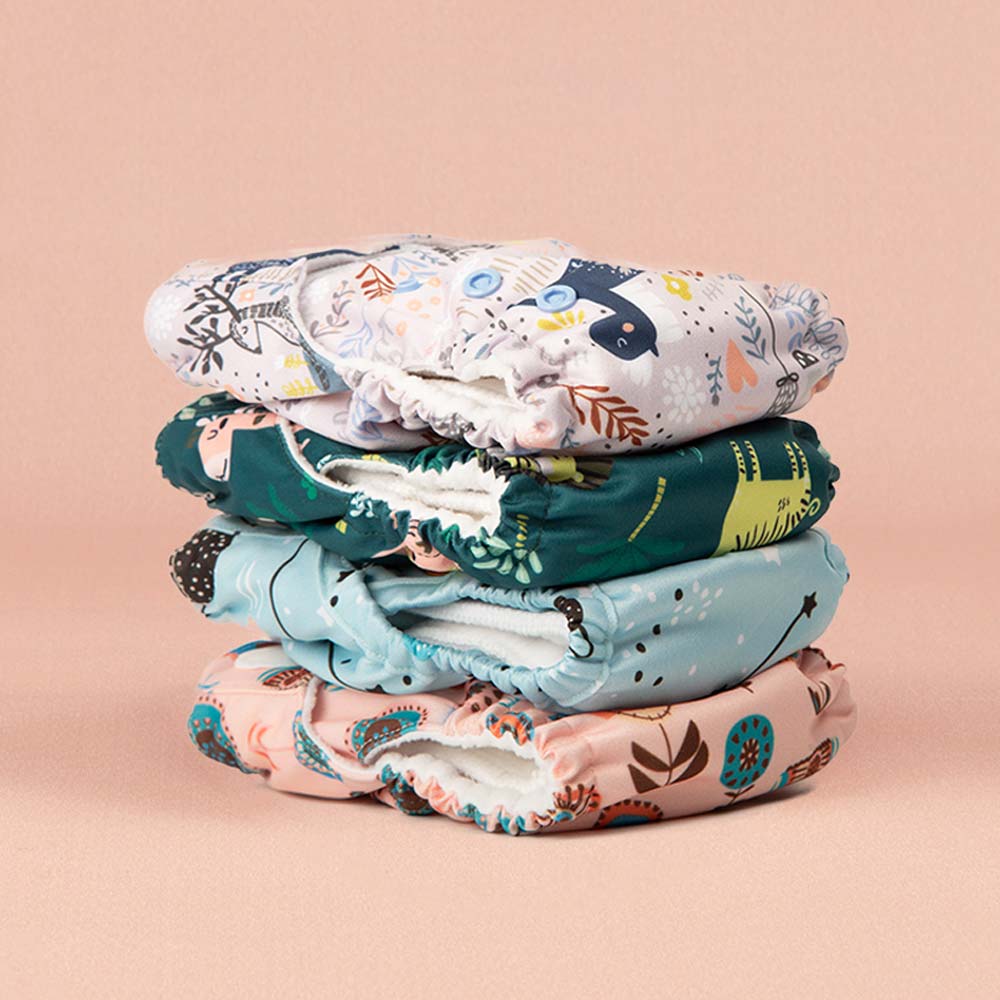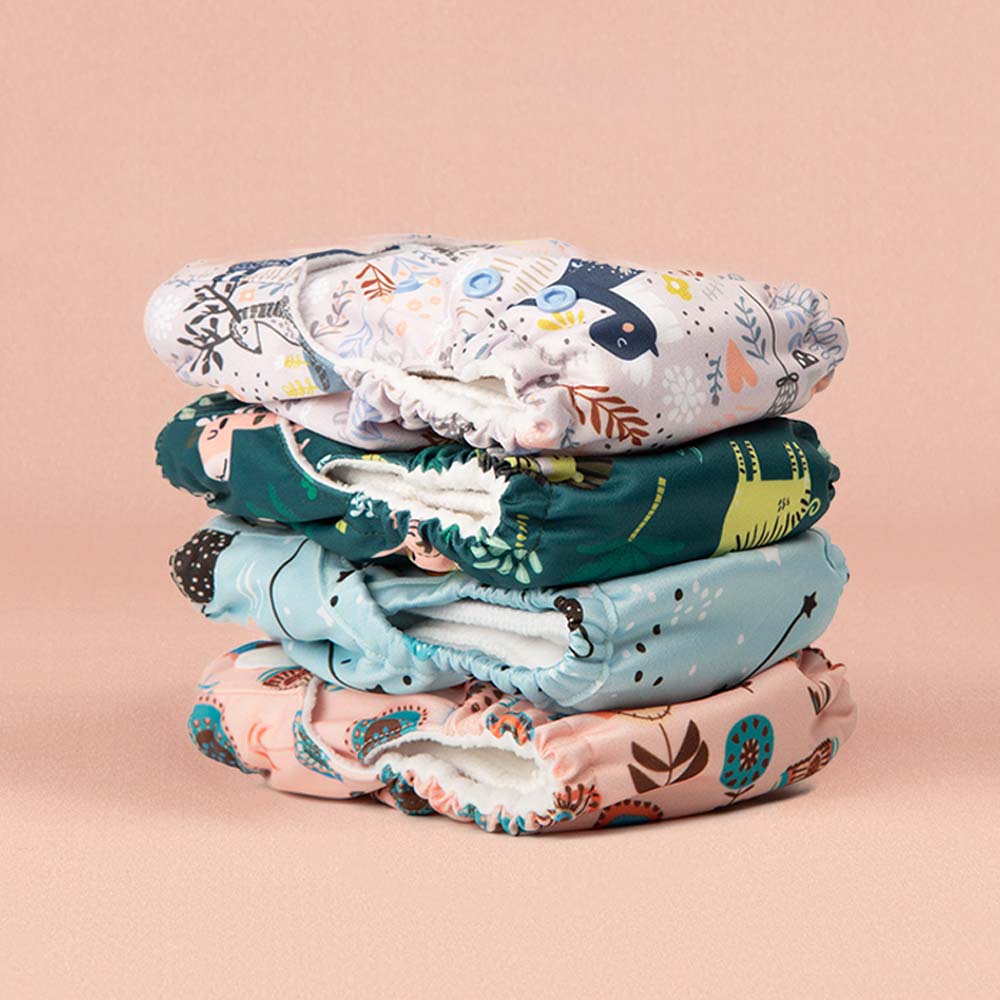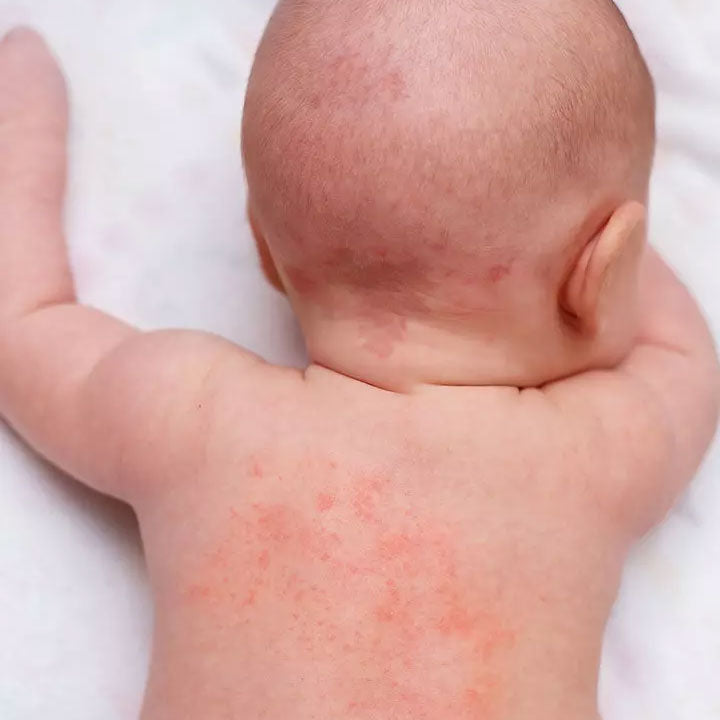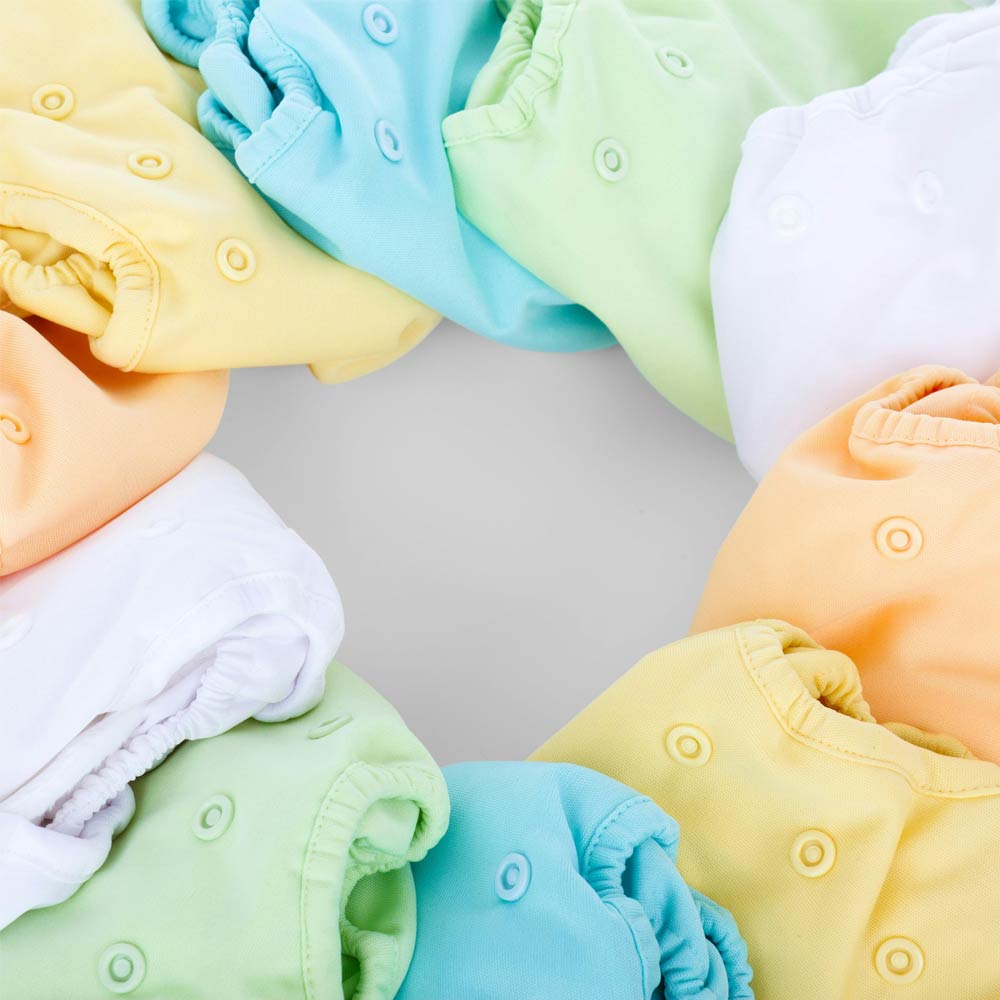
Congratulations, new parents! As you welcome your precious bundle of joy into the world, you're likely surrounded by endless decisions – from breastfeeding routines to choosing the "perfect" baby products. One of these choices, cloth diapering, might seem daunting at first. But fret not! This comprehensive guide will equip you with all the information you need to make an informed decision about cloth diapering for your little one.
What are Cloth Diapers and Why Choose Them?
Unlike disposable diapers, which are single-use and contribute significantly to landfill waste, cloth diapers are reusable and made from natural fabrics like cotton, or hemp. They come in various styles, each offering different benefits.
Pocket Diapers: These have a waterproof outer shell with a separate absorbent inner insert (pad). You can adjust the insert's absorbency for nighttime or heavy wetting periods. Pockets are popular for their ease of use, quick drying time, and versatility.
- Popular Products of this type: Aurora Max Cloth Diapers
All-in-One (AIO) Diapers: As the name suggests, AIOs are single units with an integrated absorbent layer. They're convenient, leak-proof when used properly, and perfect for on-the-go changes. These are not very popular in India as new moms prefer a quick-drying solution that makes it affordable.
Cover Diapers: These are the most convenient diapers that are preferred during rainy seasons. It has a huge advantage over washing & changing too. This waterproof cover can be used without washing for a day by just changing the pads. Although convenient, this needs extra accessories. So not many moms are a fan of it.
Fitted Diapers: These are one-piece diapers with built-in absorbency, similar to disposables but made of natural fabrics. They're easy to use but may require more time to dry.
All-in-Two (AI2) Diapers: Another popular type in India. AI2 comes with detachable inserts and boosters from the outer cover where you can use pads of your choice and still have a quick drying time after laundry.- Popular Products of this type: Just Bumm Newborn Diaper, Dream Diaper.
- Must Read: A Beginner's Guide to Cloth Diapers.
Why Choose Cloth Diapers? The Advantages for You and Your Baby
Here are some compelling reasons why cloth diapering might be the ideal choice for your family:
Eco-Friendly: Disposable diapers take hundreds of years to decompose, filling landfills and polluting the environment. Cloth diapers are reusable, significantly reducing your carbon footprint.
Cost-Effective: While there's an initial investment in buying cloth diapers and accessories, the long-term savings are substantial. You won't need to continuously buy disposable diapers for years, potentially saving thousands of rupees.
Gentler on Baby's Skin: Disposable diapers use synthetic materials that can trap moisture and irritate delicate baby skin. Cloth diapers, made of breathable natural fabrics, minimize the risk of diaper rash and provide better air circulation.
- Must Read: Are Disposable Diapers Safe For Babies?
Adjustable for a Perfect Fit: Unlike disposables that come in limited sizes, cloth diapers offer adjustability to fit your baby comfortably through different growth stages. This ensures better leak protection and prevents blowouts.
Cute and Colorful Designs: Gone are the days of plain white diapers! Cloth diapers come in a wide variety of adorable prints and patterns, adding a touch of fun to diaper changes.- Must Read: Top 5 Reasons to choose Cloth Diapers.
Common Concerns and Myths Debunked!
New moms often have questions and hesitations about cloth diapering. Here are some common concerns addressed:
Myth #1: Cloth diapering is too much work!
Truth: It requires a slight shift from your disposable diaper routine. You'll need to store soiled diapers in a pail and wash them every 2-3 days. However, modern cloth diapers are often designed for easy washing and cleaning. There are also time-saving hacks like using reusable liners to catch most of the mess.
- Must Read: How to Wash Cloth Diapers.
Myth #2: Cloth diapers leak all the time!
Truth: Leaks can happen with both disposables and cloth diapers! Finding the right fit for your baby, using the proper amount of inserts for absorbency, and ensuring a snug fit are key to leak prevention. With practice, you'll master the art of cloth diapering!
- Must Read: Hacks to prevent diaper leaks.
Myth #3: Cloth diapering is not hygienic.
Truth: When washed with a proper routine, using cold to plain water and a good detergent, cloth diapers pose no hygiene risk. It is safer than used disposable diapers tossed in the open environment causing greenhouse gas emissions.
Myth #4: Cloth diapers are expensive
Truth: While there's an initial investment, the long-term cost savings are significant. Indian brands like Just Bumm offer high-quality and affordable cloth diaper options. You can even try out cloth diapering with a small starter kit before committing to a larger stash.- Must Read: A Debunk of Cloth Diaper Myths.
Challenges You Might Face and How to Overcome Them
Embracing cloth diapering can come with its own set of challenges.
- Learning Curve: There's definitely a learning curve involved in using cloth diapers efficiently. Familiarizing yourself with different diaper styles, wash routines, and troubleshooting leaks might take some time and practice.
- Laundry Routine: You might need to adjust your laundry schedule to accommodate washing cloth diapers every 2-3 days. This may be reduced if you have enough stash for 2-3 days, so you can wash them every third day and repeat. Consider Machine Washing as it is highly efficient in washing, cleaning well, energy & water consumption.
- Travel and Outings: Cloth diapering on the go can be trickier. Pack extra diapers and wet bags for soiled ones. Pocket diapers & prefolds are convenient for travel changes as they can dry quickly when washed. It is absolutely OK to consider using disposables at times. But if you ever decide to ditch them completely, don’t ever look back.
- Social Stigma: Sadly, cloth diapering might be met with some social stigma in India. Don't let this deter you! Educate others about the environmental, health, and financial benefits of cloth diapering. You can also ignore those stigmas. Don’t let it get you! Peace.
How Many Cloth Diapers Do You Need?
The ideal number of cloth diapers depends on several factors:
- Baby's Age: Newborns tend to go through more diapers (10-15 per day) compared to older babies or toddlers.
- Laundry Routine: If you plan to wash diapers every other day, you'll need more diapers than someone washing every day.
- Diaper Type: Some diaper styles, like Pockets, may dry faster, allowing you to have a smaller stash.
Here's a general guideline for how many cloth diapers to consider:
- Newborns (0-6 months): 24-36 diapers
- Infants (6-15 months): 20-24 diapers
- Toddlers (15+ months): 16-20 diapers
Remember, this is just a starting point. Observe your baby's wetting patterns and adjust accordingly. It's better to have a few extra diapers on hand than run out unexpectedly.
Exclusive Indian Tip: Most Indian Mommies tend to have langots in their stash. This significantly reduces cost, drying time, and also effective laundry. Langots are more helpful in keeping a baby’s pee count, especially for newborn babies. By using langots & cotton nappies for diaper free time for babies, you can prevent rashes as they are even more breathable than cloth diapers.Issues to Avoid: Buildup, Sizing, Wearing, and Material Leaks
While cloth diapering offers numerous benefits, there are some potential issues to be aware of:
Buildup Due to Improper Washing: Choosing the wrong detergents, inadequate rinsing, or not adding water softener for hard water can lead to detergent and mineral buildup. This reduces absorbency and can cause leaks. Use a good, active power detergent, rinse diapers thoroughly, and follow the brand’s specific wash instructions.
Improper Sizing: A diaper that's too loose won't contain leaks effectively, and one that's too tight can be uncomfortable for your baby. Ensure a snug but comfortable fit around the legs and waist. Opt for Cloth Diapers that have rise settings. Because leaks are always an issue with those fake no-rise ones.
Improper Wearing: Double-check that the diaper is worn correctly, with all the absorbent inserts positioned in the designated area. Ensure leg gussets (elastics) are properly positioned to prevent leaks. Double gussets are not popular in India due to the relatively high red marks left behind.
- Must Read: How to Size & Wear Cloth diapers for babies.
Additional Tips for Successful Cloth Diapering
- Join online cloth diapering communities: You are free to connect with other moms for support, troubleshooting tips, and recommendations. But recommendations are different from brand to brand. Always reach out to the brand’s customer support first. While other moms can offer tips, Brands offers solutions.
- Don't be afraid to experiment: You can experiment with different diaper styles, inserts, and wash routines that might work better for your baby and lifestyle.
- Be patient: Like any new routine, there's a learning curve with cloth diapering. Don't get discouraged if you encounter leaks initially. Practice makes perfect! Get in touch with the brand to sort out the issue. Remember, be patient, and do not lose your cool.
Cloth Diapering in India: A Boon for the Environment and Your Wallet
With India's growing population and increasing disposable diaper use, the environmental impact is significant. Choosing cloth diapers is a conscious step towards reducing waste and protecting our planet. Furthermore, the long-term cost savings of cloth diapering are undeniable, especially considering the rising cost of disposable diapers.
Conclusion: Embrace the Journey of Cloth Diapering!
Cloth diapering is a fantastic choice for eco-conscious moms who want the best for their babies. While it requires a shift from the convenience of disposables, the benefits outweigh the challenges. With the right information, preparation, and a supportive community & brand, you can embark on this rewarding journey of cloth diapering your little one. Remember, a happy and healthy baby, a clean environment, and a lighter wallet – that's the power of cloth diapering!
Frequently Asked Questions:
Is cloth diapering suitable for all babies, including those with sensitive skin or allergies?
Cloth Diapers are suitable for all babies. But if your baby is known to have fleece sensitivity or is eczema prone opt for 100% Organic Cotton langots and nappies like Kewt Langots & Fluffie.
Can cloth diapers handle nighttime wetting? If so, what are some strategies to ensure leak-proof nights?
Yes. Cloth Diapers are suitable for nighttime. The best combo is Organic Cotton & Hemp booster that has at least 20 layers of padding. Always empty your baby's bladder before wearing the nighttime diaper, right before going to bed.
What are some traditional Indian diaper alternatives (like langots) that can be used alongside cloth diapers?
Almost all Indian Mothers prefer to use langots and cloth diapers in turn. They use langots & nappies that holds one pee for diaper free time during the day and change to cloth diapers for nighttime, nap time and travel. You can use Kewt Langots and Fluffie for your baby.
How can I deal with diaper rash if my baby experiences it while using cloth diapers?
Diaper rashes are common in diapers that contain chemicals or that are less breathable. With Cloth diapers, improper washing, not changing frequently & hard water are the reasons. You can opt for more breathable options by putting your baby in langots like Kewt Langots or Fluffie, give them more diaper free time. Then you can follow up with the washing mistakes and adjust them accordingly. Get in touch with the brand for more appropriate troubleshooting.
How long can I realistically use cloth diapers on my baby? Do they become less effective as my child grows?
Cloth diapers are more helpful in smoothly making a transition to underwears than disposable diapers. If you want to potty train your toddler, start at the right time which is 2 years. If you find your cloth diapers losing absorbency, consider changing the pads every 8 months or every year.



Leave a comment
All comments are moderated before being published.
This site is protected by hCaptcha and the hCaptcha Privacy Policy and Terms of Service apply.